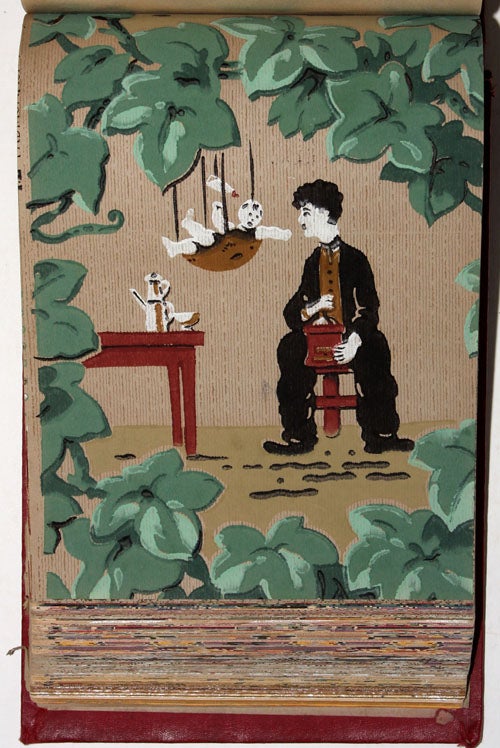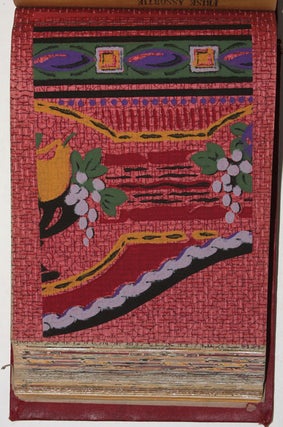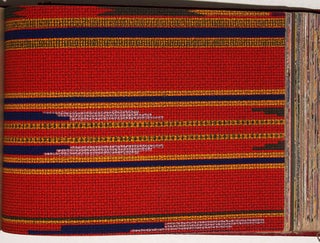L. D. M. Paris. Nouveautés. No. 10.
Oblong folio, [35.1 x 21.6 cm], 479 single-sided wallpaper samples, 419 of which are numbered 1001-1434 with an ink stamp on verso and 60 of which are unnumbered half-size sheets (missing are numbers 1012, 1076, 1114, 1116, 1117, 1176, 1177, 1197, 1205, 1265, 1368, 1369, 1375, 1426, 1427). Bound in red buckram, leaves secured by two metal rivets, title gold stamped on upper cover. Upper cover loosely secured by buckram covering, minor rubbing to boards, some wear to edges and corners, advertisement for Quellhyd glue pasted inside upper cover. Some plates with minor toning from adjacent leaves, some plates with transfer from verso ink numbering, a few samples torn (1428, 1432 and 1434), some samples with pasted on mock-up design leaves (1094, 1100, 1227, 1229, 1243, 1249), very minor edge wear here and there. Overall excellently preserved with colors perfectly fresh.
Remarkable volume of block-printed wallpaper samples from 1920s Paris, a collection of 479 examples of this decorative art showcasing both traditional designs and the most current (and often wonderfully garish) art deco styles. The volume, stamped L. D. M. Paris on its upper cover, is an archive of Roaring Twenties wallpapers decorated with stripes, geometrical designs, floral and fruit motifs, landscapes, pastoral scenes, classical and oriental motifs, and animal designs. A wide variety of printing techniques and paper stocks are used, with many examples printed with glittering gold and silver inks and in dazzling colors. Some 60 of the designs are paired with half-sheets suggesting coordinating friezes, borders, or mouldings. To a handful of the designs have been pasted black-and-white printed mock-ups of how such pairings might look on the wall.
Leaves are inked stamped on their versos with consecutive reference numbers and short labels about usage (frise assortie, cretonne assortie, toile assortie, combinaison, plafond). At the edge of some sheets are printed details about origin (e.g., Fabrication française) or design titles (e.g., Vigne vierge). A few samples are marked as being washable (lavable “sana”). It must be surmised that the sampler collects examples from several producers, but specific evidence of a manufacturer can be found only on a few sheets, and those refer to the famous Zuber & Co. factory in Rixheim, a firm still in operation today and perhaps the last company still making block-printed papers and fabrics in this manner (see samples 1136, 1220, and 1221, labeled “Zuber & Cie (Alsace)”). As elegant as these Zuber examples are, perhaps the most intriguing design in the sampler is that stamped number 1264: It depicts (rather freely) Charlie Chaplin in his famous scene from The Kid (1921) in which the Little Tramp tries to feed the foundling (precariously hanging from a miniature hammock) using the spout of a teakettle; the design was presumably intended for the walls of a nursery decorated by movie-going parents. An adjacent sample depicts the young Breton housemaid Bécassine, the first female protagonist in the history of comics (perhaps from L’enfance de Bécassine [1913]).
Sold




